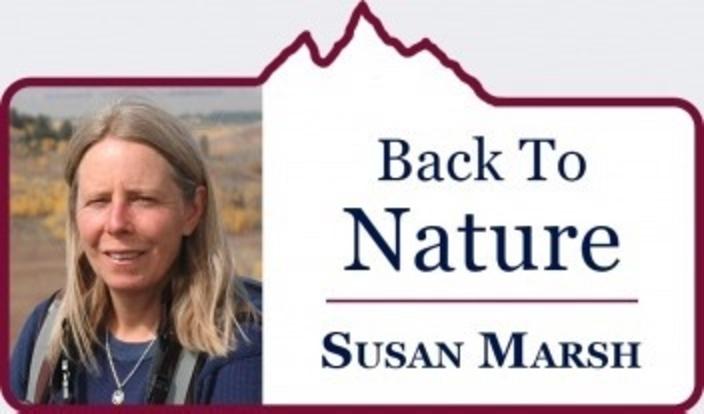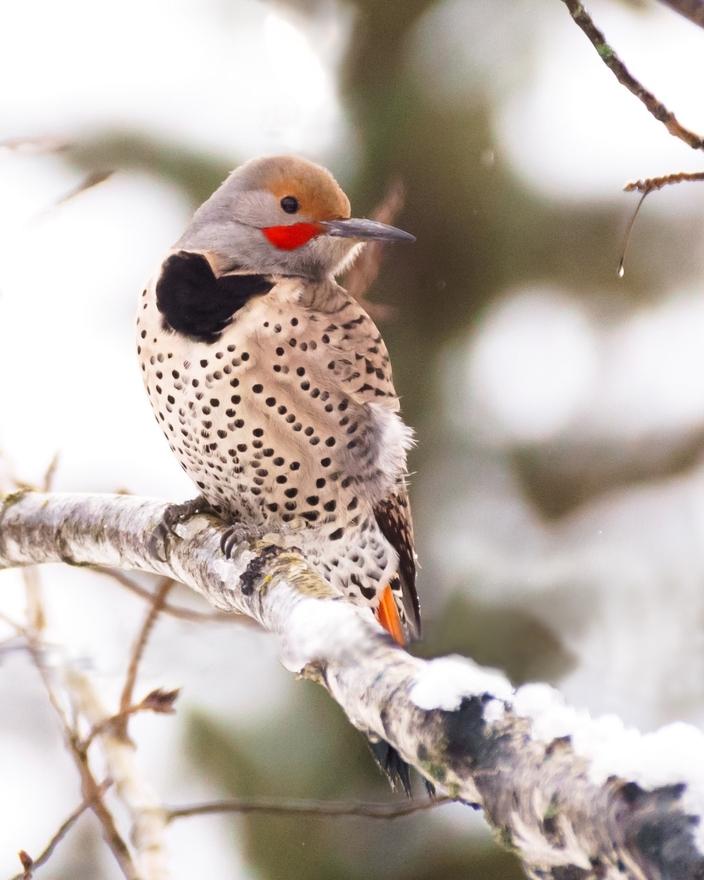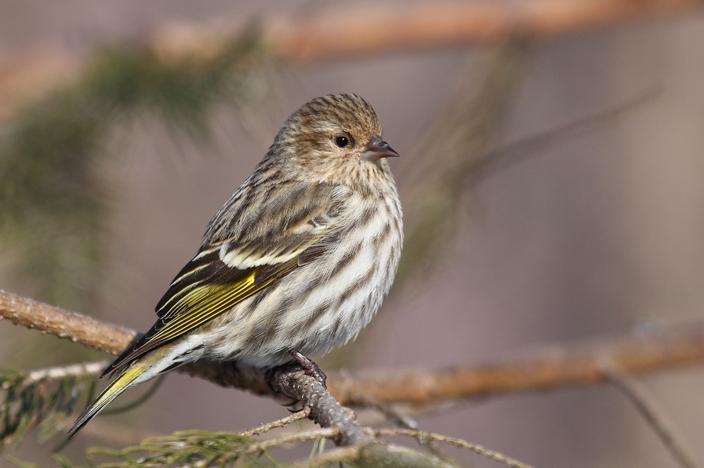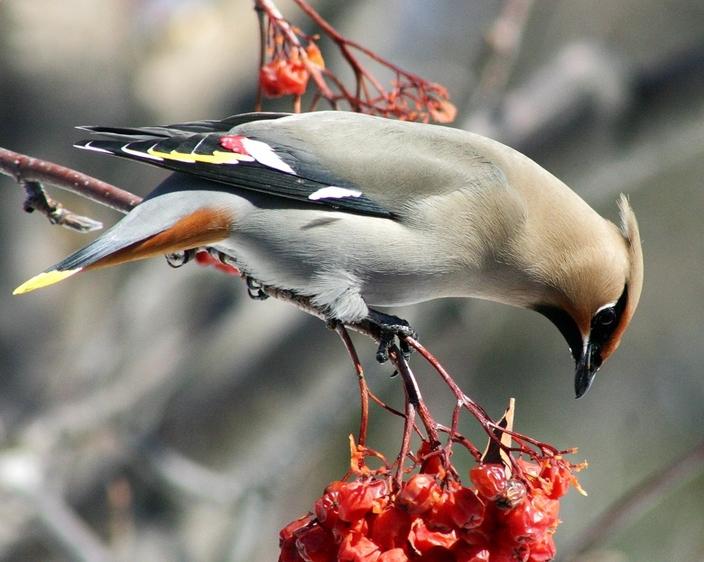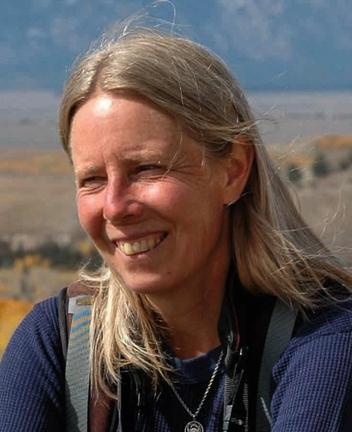Back to StoriesMy Golden Weeping Willow—Finding Grounding In The Spectacular Ordinary
February 1, 2018
My Golden Weeping Willow—Finding Grounding In The Spectacular OrdinaryNaturalist Susan Marsh opens her old journal and muses on boredom, beauty, impermanence and the lament of a tree cut down
When I worked at the Bridger-Teton National Forest in the late 1980s, my office window faced south, toward Snow King and
the mountains to the east of Jackson. A mature golden willow spread its shade
across the lawn next to the building, and during the summer it was hard to see
past it. When the tree was bare of leaves, which meant for about six months of
the year, I looked through its interlacing branches to watch skiers on the hill
and swans flying low between patches of open water along Flat Creek.
At first I looked through the
willow, the same way I did the window. I knew the tree was there, of course,
but I didn’t really see it. I was used to charging into the office in the
morning and banging on the computer keyboard to get through my e-mail before
8 am when everyone else showed up and the interruptions began. After 20
minutes, my messages were deleted or stored or turned into jotted notes and
appointments on the calendar: call so-and so, send someone this document, get
this report to the regional office in Ogden next week. Then it was off to a
meeting or a field review or, if I was lucky, a horseback ride with one of the
district rangers.
Even in the midst of rushing
around, my busyness struck me as ridiculous. I lived in the mountains where
other people came to relax on vacation, while I’d fallen into a frenzied pace,
surrounded by distractions from the world of seasons, light, and living things.
The reasons people come here to play, or stay.
Near the start of another year I promised
to slow down. I bought a notebook and put it in my desk drawer, determined to take five minutes each
morning before doing anything else and write random thoughts about what was
important for the day, what I noticed while walking to work, or whatever was on
my mind that needed clearing before I could devote my full attention to the
job.
Writing in a notebook was acceptable to me, while sitting
at my desk without it was not. It didn’t occur to me at the time that I was
equally unable to sit without doing something for very long anywhere, whether
at work, home or out in the woods. I thought about the quote that a friend who
meditated had taped to her wall: Don’t
just do something; sit there.
A different mantra had been
drummed into me: be productive, get something done, don’t mope around the house.
“If you’re bored,” my mother said, “I’ll give you something to do.”
The first time I heard this
spoken by a boss, I was 19. After my freshman year in college I took a year off
and moved into a rooming house in Seattle’s University District. My vague goal
was to figure out who I was and what I wanted to do, and to save a little
money. I found a part-time position at Frederick and Nelson’s department store
downtown, which included a semi-formal dining room and a less formal soda
fountain. I worked at the fountain, where customers sat at marble counters like
those in an old-fashioned drugstore. A trickle of hatted, gloved ladies broke
the quiet of morning and a thinner trickle arrived in the afternoon. Lunch hour
was the only time they interrupted their shopping for refreshment. I wiped
counters and made sure the soda glasses were carefully arranged, and then I basically
stood around.
“What should I do when there are no
customers?” I asked my supervisor.
He tossed me a damp cloth. “Just look busy.”
I wiped the clean countertop again.
Bored
out of my mind, invisible to the patrons unless I made a mistake, about which
they loudly complained, I quickly felt imprisoned. Looking busy was harder than
actually being busy. When break time came around, I could help myself to anything
waiting in the kitchen—fresh cantaloupe, soup, sandwiches. Most days I sat in the
windowless employee ‘lounge’ with the door closed, eating a hot fudge sundae.
Whenever I felt sorry for myself, ice cream was my drug of choice.
I may
not have shone at making malts and serving grilled cheese sandwiches, but I was
well practiced at the art of being busy. By the time I was in high school, even
recreation was performance. I ran laps on the local high school track to be in
shape for backpacking and climbing mountains. Throughout my twenties and thirties
I ran five miles a day. In my forties, I jogged. After fifty, I walked. See, I tell myself now, at 65, you’ve finally
slowed down.
On a January morning, I opened my
new notebook and passed my hand over the smooth lined pages, the clean brown
cover. It smelled like paper, not smeared ink and spilled coffee and onions
from a sandwich eaten at my desk. I’ll write neatly, I thought, and keep these
pages clean, ready for moments of inspiration.
As I gazed out the window wondering
what I was going to write about, my pen began to doodle on its own, drawing
little curlicues and geometric forms. I glanced down to see that I’d marred the
pristine page the way I promised not to. But because of it, the need to write
profound words of wisdom evaporated and I gave more serious thought to the
reason I’d bought the thing to begin with.
One of those two-by-four to the
head moments occurred: it’s the tree, dummy. It stood there as the obvious
slowly dawned on me. I stopped looking through the willow and actually saw it.
Standing there as it had done for years.
Trees don’t just stand there,
they’re busy. Roots probe the soil, nutrients are exchanged with fungi, buds
form and open and branches grow long, fluids are pumped up and down the cambium
layer, leaves work hard for a few sunny months then fall away to be replaced
the next year, injuries and insect attacks are monitored and dealt with, and
wood and bark are added to create a fortress of a plant. Trees do the opposite
of people—instead of looking busy they appear to be the picture of repose.
From my purposes, the willow waited
patiently, quietly, and it wasn’t going anywhere. It gave me focus, something
to start writing about as a simple object of observation. My jottings might capture
one of the occasional insights that rocketed through my brain like comets, leaving
little besides trails of dust. The willow was my neighbor and I needed to make
its acquaintance.
The golden willow is a cultivar of an Old World species, not native to Wyoming. Many people consider them to be weeds. But when you’re looking for a fast-maturing shade tree in a climate with a growing season of about two months, the golden willow is hard to beat.
The golden willow is a cultivar of an
Old World species, not native to Wyoming. Many people consider them to be
weeds. But when you’re looking for a fast-maturing shade tree in a climate with
a growing season of about two months, the golden willow is hard to beat. Its
cascades of yellow catkins are fragrant in spring, giving bees something to do
when not much else is in bloom. Its bright-orange twigs offer the only color in
town on a drab late winter day. And the willows are full of aphids and other
bugs during fall migration. Vireos, kinglets and warblers spend days in their
crowns, filling up for flight. Woodpeckers, flickers, nuthatches and sapsuckers
probe the furrowed bark for other insect treats. So, introduced weeds or not,
golden willows aren’t without their usefulness.
In the early 1990s “my” willow was slated for removal. Its
branches grew into the phone lines and its roots into the septic system. Its five
main trunks were thick and heavy and thus assumed to be rotten. The tree was
declared a hazard, although anyone could see that it protected itself from wind-throw
quite well with a network of fine-textured branches that broke the wind and
came off like lizard’s tails when a gust blew through, much to the annoyance of
our groundskeeper who had to pick them up.
Until the tree outside my office
window was in danger, I didn’t realize I wasn’t the only one to appreciate its
shade, the rustle of wind in its branches, and the illusion of being in the
woods that it offered when my eyes, weary from staring at the computer screen,
drifted toward the sunlight. Even the groundskeeper liked it.
Enough of us raised hell that the
tree was trimmed—quite heavily—and not cut down. I was glad for its reprieve,
not only for its own sake but for the gifts it had given me. While much of my
work took place outside, over the years more and more had to be done by
computer and conference call. The tree served to reconnect me with the humane
pace of the wild world whenever I looked at it.
° ° °
Here are a couple of my early notebook
entries:
January: The morning
sun has begun to light up the willow outside. The tree fills my view with its bare
branches. The roofs of buildings and the forested ridge beyond look like a
Christmas card scene. It snowed last night, just enough to dust the rooftops
and leave lines of white along the curve of each willow branch. If I squint a
little, it looks like a finely carved woodcut. When was the last time I did a
woodcut? [Before I started another sentence the phone rang. A quarter after
seven—really? My day began and the notebook went back into the drawer.]
Mid-February: This
morning the wind came up and knocked last evening’s snow from the willow
branches. The tree is full of pine siskins. Their short, rasping call ends with
a question: is it spring yet? I have begun to notice a difference in the
siskins. All winter at my feeder they were drab and tolerant of each other. Now
the yellow in their wings has brightened and they challenge each other with
open beaks and flapping wings, crouching possessively over the sunflower seeds. They seem to use more energy fighting than
they get from the seeds.
After a month, noticing the willow has
become a habit I look forward to, but interruptions continue to pull me away. Urgent
tasks demand attention; I give in to discover the need was not so urgent after
all. The messages on my computer inbox pile into the hundreds, most of them unnecessary,
outdated bits of information. But I have to take the time to read each one to
see whether I needed to look at it or not.
The willow demands nothing. It has no deadlines, but if I don’t pay
attention I’m out of luck. I almost missed the goldeneyes that just flew over,
their wings whistling loudly enough that I could hear them through the closed
window.
It is light now when I leave the house
for the walk to work. Every day for a week the coyotes have been singing, their
yodels and yips close and hungry. They gather on a grassy knob above the east
end of town, where the road to the Elk Refuge leaves pavement. It is at least a
half-mile away, but the coyote voices penetrate, as if they were next door.
End of February: Snowstorms
alternate with warm, gentle days. The sun angle is higher, the light softer. The
sky has gone from cobalt blue to a color closer to turquoise with yellow
highlights. The cold air that slammed against my brow in January has turned to
a caress, broken by soft breezes. A winter’s worth of gravel disintegrates to
dust in the streets, where the wind picks it up and blows it into my face. I
grind it between my molars.
The wild creatures seem to know winter
is nearly over. Chickadees repeat their spring song. Last week near Kelly Warm
Springs, a dozen adult bison nibbled at the ground then suddenly ran together
with their heads down, kicking their heels at the sky like calves. Flocks of
waxwings sweep through town, picking cotoneasters and wild rose bushes clean of
berries, conversing in their gentle peeps from the willow. This morning finches claim the willow,
singing, weaving themselves among the branches like a moving rosy garland.
The birds’ restlessness reflects my own. I clean my office, dust the
shelves, open the window on mild afternoons. At lunchtime I wander across town,
checking out the newly raked flowerbeds where folded leaves and shoots emerge,
perfectly formed and poised for action. The aspen buds have broken, exposing furry
silver globes. The willow tree brightens, the ocher of its smaller branches
glowing in the morning sun.
° ° °
And so on, little blurbs of observation written over
the course of a couple of years. No big insights left their comet trails. I saw
no unusual birds. But the practice of noticing, of giving attention to
something familiar day after day, helped me understand and appreciate it more. I
came to think of that tree and my friend and mentor. It helped me to appreciate
many other ordinary things. Though if you think about it, trees, while covering
much of the planet in their multitudes, are anything but ordinary.
My encounters with the golden willow took place close
to 25 years ago. Now I am retired, and the tree is hardly a memory as the new Bridger-Teton
Forest supervisor’s office, planned since 1995, has finally been completed.
Nearly all of the old trees were sacrificed for construction—willows, cottonwoods,
aspens, and big shaggy spruces. They have been replaced by an assemblage of
horticultural plants that would look more at home in a business park in
Portland. When the groundskeeper retired, before the old building was razed, he
went around and hugged each of the trees he had looked after, trees he knew
were doomed.
The willow did what we all do. It survived as long as possible, then gracefully surrendered to what we humans like to call progress. I have recently heard that the mule deer that used to winter in the willow wetlands behind the old office still come by, wondering what happened to their haven.
The
willow did what we all do. It survived as long as possible, then gracefully
surrendered to what we humans like to call progress. I have recently heard that
the mule deer that used to winter in the willow wetlands behind the old office
still come by, wondering what happened to their haven. I heard that people dug
the tulip bulbs to take home and someone bucked the trunk of the golden willow
for firewood.
It
pleases me to know that remnants of the old landscaping have survived in
people’s gardens, or were put to use in a woodstove. And knowing willows, I would
not be surprised to see a returning apparition of the golden willow whose roots
still linger in the soil. It might send up a subversive sprout to invade the
ill-adapted Irish moss and Japanese spirea. It might provide a corner of shade against
the building once again.


